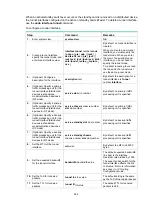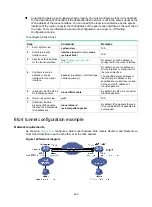
298
[RouterA] interface gigabitethernet 2/0/1
[RouterA-GigabitEthernet2/0/1] ip address 192.168.100.1 255.255.255.0
[RouterA-GigabitEthernet2/0/1] quit
# Create an automatic IPv4-compatible IPv6 tunnel.
[RouterA] interface tunnel 0 mode ipv6-ipv4 auto-tunnel
# Specify an IPv4-compatible IPv6 address for the tunnel interface.
[RouterA-Tunnel0] ipv6 address ::192.168.100.1/96
# Specify GigabitEthernet 2/0/1 as the source interface of the tunnel interface.
[RouterA-Tunnel0] source gigabitethernet 2/0/1
•
Configure Router B:
# Specify an IPv4 address for GigabitEthernet 2/0/1.
<RouterB> system-view
[RouterB] interface gigabitethernet 2/0/1
[RouterB-GigabitEthernet2/0/1] ip address 192.168.50.1 255.255.255.0
[RouterB-GigabitEthernet2/0/1] quit
# Create an automatic IPv4-compatible IPv6 tunnel.
[RouterB] interface tunnel 0 mode ipv6-ipv4 auto-tunnel
# Specify an IPv4-compatible IPv6 address for the tunnel interface.
[RouterB-Tunnel0] ipv6 address ::192.168.50.1/96
# Specify GigabitEthernet 2/0/1 as the source interface of the tunnel interface.
[RouterB-Tunnel0] source gigabitethernet 2/0/1
Verifying the configuration
# Use the
display ipv6 interface
command to display tunnel interface status on Router A and
Router B. Verify that the interface tunnel 0 is up. (Details not shown.)
# Verify that Router B and Router A can ping the IPv4-compatible IPv6 address of each other. The
following shows the output on Router A.
[RouterA-Tunnel0] ping ipv6 ::192.168.50.1
Ping6(56 data bytes) ::192.168.100.1 --> ::192.168.50.1, press CTRL_C to break
56 bytes from ::192.168.50.1, icmp_seq=0 hlim=64 time=17.000 ms
56 bytes from ::192.168.50.1, icmp_seq=1 hlim=64 time=9.000 ms
56 bytes from ::192.168.50.1, icmp_seq=2 hlim=64 time=11.000 ms
56 bytes from ::192.168.50.1, icmp_seq=3 hlim=64 time=9.000 ms
56 bytes from ::192.168.50.1, icmp_seq=4 hlim=64 time=11.000 ms
--- Ping6 statistics for ::192.168.50.1 ---
5 packet(s) transmitted, 5 packet(s) received, 0.0% packet loss
round-trip min/avg/max/std-dev = 9.000/11.400/17.000/2.939 ms
Configuring a 6to4 tunnel
Follow these guidelines when you configure a 6to4 tunnel:
•
You do not need to configure a destination address for a 6to4 tunnel, because the destination
IPv4 address is embedded in the 6to4 IPv6 address.
•
Do not specify the same source addresses for local tunnel interfaces in the same tunnel mode.
















































